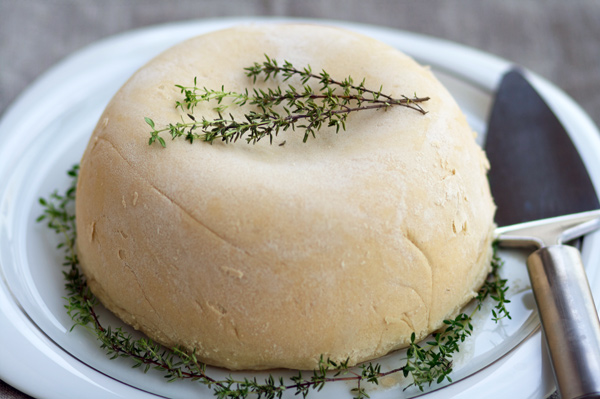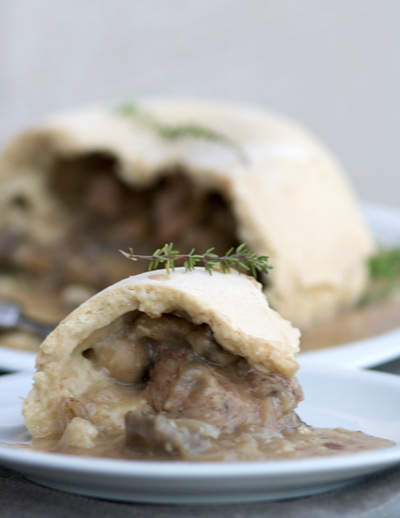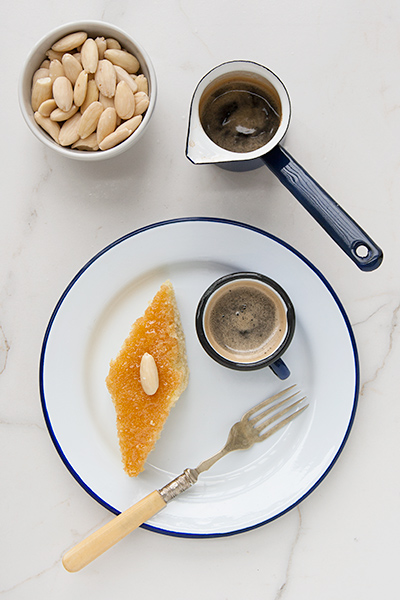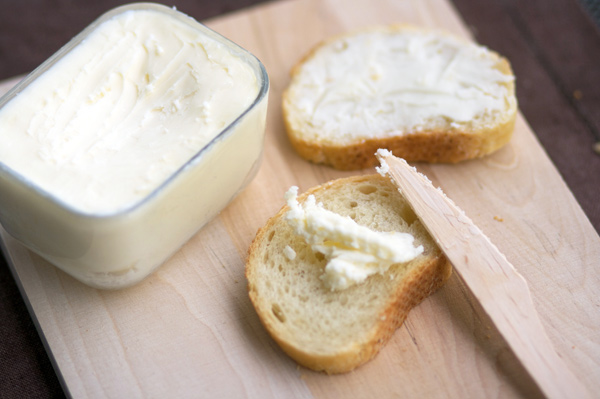Steak and mushroom pudding – Daring Bakers’ Challenge
Un autentico British pudding fatto in casa: questa era la sfida dei Daring Bakers del mese di Aprile, un’idea proposta da Esther di The Lilac Kitchen che ho subito accolto con entusiasmo, anche se con un po’ di panico: come prima ricetta da Daring Baker il pudding mi pareva di una difficoltà insormontabile.
Manuel ed io abbiamo dunque unito le forze per affrontare la sfida: ci siamo messi ai fornelli, armati di tutti gli ingredienti incluso l’introvabile “suet” di cui vi spiegherò più avanti e ci siamo dedicati con impegno al pudding.
Dopo esattamente 5 ore ho sfornato la più avventurosa ricetta che sia mai comparsa su questo sito: l’irresistibile steak and mushroom pudding.
Take me to the English version of this post!
Per preparare questa ricetta ho dovuto studiare moltissimo (non sto scherzando!): esistono diversi tipi di pudding, infiniti possibili ripieni, svariati metodi di cottura… decidere sul da farsi sembrava impossibile!
Esther aveva dato soltanto due indicazioni: il pudding doveva essere cotto nella maniera tradizionale, vale a dire al vapore, e doveva contenere un ingrediente estremamente British, il suet.
Il suet è grasso di manzo o di agnello, raccolto in particolare dall’area dei lombi e del fegato dell’animale: bello e invitante eh?
Il suet (s)fortunatamente nel nostro paese non esiste: le alternative erano il lardo (bleah!), il burro (sconsigliato dalla stessa Esther) o il vegetable suet, che è grasso di origine vegetale.
Il mio amico Daniele era in Inghilterra proprio nei giorni successivi all’annuncio della daring bakers’ challenge, dunque l’ho mandato alla ricerca del vegetable suet, che è arrivato sano e salvo in Italia pronto per entrare nel pudding.
Conquistato il vegetable suet io e Manuel eravamo pronti a procedere con la preparazione del pudding, che ora vi racconto.
Mi sono fidata della ricetta di una tizia trovata su YouTube, il cui accento meraviglioso mi ispirava molta fiducia; il suo steak and mushroom pudding era esattamente quello che io avevo in mente di preparare e la ricetta non ha tradito le mie aspettative: il pudding è venuto miracolosamente perfetto e… delizioso in un modo irripetibile!
- 300 g di carne tipo spezzatino
- 150 g di funghi champignon interi
- 2 cucchiai di farina
- 1/2 cipolla
- 1 cucchiaino di timo, meglio se fresco
- 90 ml di birra
- un po’ di salsa Worcestershire
- sale e pepe q.b.
- 250 g di farina
- 1 bustina di lievito secco
- 90 g di vegetable suet
- acqua q.b.
- 1 pizzico di sale
In una ciotola capiente impastate la farina, il lievito e il vegetable suet con l’acqua: quello che volete ottenere è un impasto della consistenza di quello del pane, appena più morbido direi, quindi regolate l’aggiunta di farina o di acqua a seconda delle vostre esigenze.
Quando l’impasto vi sembra pronto, stendetelo col mattarello e adoperatelo per foderare il vostro stampo da pudding, che avrete precedentemente imburrato e infarinato per benino: lasciatene tuttavia da parte un pezzo, che servirà per chiudere il pudding quando l’avrete riempito.
Lavate bene i funghi, tagliate la carne in cubetti, la cipolla a fettine sottili e unite il tutto in un’altra ciotola grande: aggiungete la farina, il timo, la birra, la salsa Worchestershire e mescolate bene con un cucchiaio, per ottenere il ripieno del pudding.
Riempite lo stampo e chiudetelo superiormente con lo strato di impasto che avete tenuto da parte.
Quando il pudding è pronto, coprite lo stampo da pudding con uno strato di carta da forno e uno di carta stagnola, che serviranno a proteggere la superficie del pudding dal vapore acqueo.
Mettete il pudding in nel cestello della vaporiera (pentola per la cottura al vapore) e fatelo cuocere per 4 ore, tenendo presente che è necessario aggiungere acqua già bollente nella pentola circa ogni mezz’ora, perchè ovviamente il pudding non può rimanere senza vapore.
Trascorse le 4 ore tirate graziosamente fuori il pudding dalla pentola e scodellatelo fuori dallo stampo con bello slancio, non prima di aver staccato delicatamente il pudding dai bordi dello stampo con un coltello.
Fate in modo di mettere il pudding su un piatto col bordo alto, che possa contenere tutto il delizioso gravy proveniente dal pudding una volta apertolo.
Affettate il pudding, servitelo nel piatto magari con qualche verdura poi… enjoy!
*
The April 2010 Daring Bakers’ challenge was hosted by Esther of The Lilac Kitchen. She challenged everyone to make a traditional British pudding using, if possible, a very traditional British ingredient: suet.
When I read that the Daring Bakers challenge for this month was going to be a typical British pudding I was bursting with enthusiasm: I love British recipes! On the other hand, I was pretty damn frightened because I had never tried such a difficult recipe before: it called for”exotic” ingredients like suet (I didn’t even know suet existed on earth!) and 4 hours of careful steaming… I mean, the whole task sounds really odd, doesn’t it?!
Manuel and I decided to join forces for the difficult assignment, so we arranged to spend sunday afternoon in the kitchen preparing our first ever traditional British pudding.
We chose a recipe online and went through with it bravely. I wasn’t very confident on the outcome of the recipe, but – in the end – the result was astonishing: the pudding turned out perfect!!
Our first pudding was not only aesthetically fabulous, but also terrific to taste, really excellent!!
I truly do suggest that you try this recipe: it takes time, but the pudding is a real treat!
- 300 g casserole beef
- 150 g button mushrooms
- 2 tablespoons plain flour
- 1/2 peeled onion, thinly sliced
- 1 teaspoon fresh thyme
- 90 ml beer
- a bit of Worcestershire sauce
- salt and pepper
- 250 g plain flour
- 1 bag of dry yeast
- 90 g vegetable suet
- water as needed
- 1 pinch of salt
Combine the meat, the onion and the mushrooms in a bowl, adding the flour so that it coats the meat, then add salt, pepper, thyme, beer and Worcestershire sauce and mix well.
To make the pastry, place the flour into a bowl and work energetically to incorporate the suet and water (as needed): the aim is to obtain a firm but elastic dough, similar to the one which is used for bread.
Roll the dough out on the work surface, lifting and turning it so it doesn’t stick to the table; meanwhile, butter a pudding bowl and cover it in flour.
Cut out a quarter of the dough to use for the lid; place the rest of the dough into the pudding bowl, pressing it against the sides, bottom and top of the bowl. Afterwards fill the pie, making sure the filling fills the pudding bowl to the brim. Brush water on the edges of the pie and place the piece of the dough for the lid on top of your pudding.
Now it’s time to steam the pudding: cover the pudding in baking parchment and seal it in foil, place it in a steamer and cover it with a lid. Steam the pudding for 4 hours, going back to check that the bottom pan hasn’t run out of water approximately every 30 minutes.
When finished steaming, remove foil and parchment from the pudding; loosen the pudding around the edges with a palette knife, tip it onto a plate with a lid then lift up the bowl and welcome your perfect creature.
Cut into the pudding and you’re ready to eat: enjoy!!








ma che meraviglia, ma siete fantastici!!bravi bravissimi!!
Siete stati bravissimi!!!
Grandi ragazzi!! io questo mese ho dato forfait, sigh!
DEcisamente la più avventurosa… Ma come vi è venuto di preparare questa cosa? sinceramente è la prima volta che la vedo e la sento. Grandi! Bacio
ohhhh che meraviglia questo pudding con ripieno!!!! davvero goloso!
@Valeria @alem @Ely grazie! :)
@Juls ma no! non ce la fai proprio? secondo me fai ancora in tempo, non solo hai tutta la giornata di oggi ma pare che ci sia anche una specie di settimana di tolleranza per cui va bene lo stesso… daiii!! io volevo vederla la tua ricetta!!
@Elisakitty’s Kitchen è per i daring bakers, non era una nostra idea! insomma, il tema era fare un pudding alla maniera tradizionale e questo ci sembrava umanamente fattibile… :)
Jasmine!
Il pudding! Oddio il suet mi fa una certa impressione, devo dire. Ma io sono erbivora..
Anche io!!! Infatti ho usato quello vegetariano, fatto solo con verdura :D
I’m so impressed that you did this challenge and it turned out so good. Superb effort and it looks so delicious. Bravo. Cheers from Audax in Sydney Australia.
Ammazza complimeti ad entrambi allora!!! Non potevate fare di meglio.. mi sembra bellissimo e pure gustoso visto dall’interno!!! smackkk buona giornata…:-D
The pudding looks fantastic! It’s really turned out beautifully. Great photography with a very hard subject to photograph.
non ho mai provato una ricetta simile, mi è del tutto nuova e come tutte le novità mi incuriosisce!
@Audax thank you!! I appreciate your kind words very much: you’re a pudding master!! :) Cheers!
@claudia ce l’abbiamo messa tutta: è stato molto avventuroso :) buona giornata anche a te!!
@Lisa Thank you Lisa! It was indeed a hard subject, I’m glad you like my pictures! By the way, your harlequin pudding is lovely!!
@Micaela se hai un intero pomeriggio in cui non hai nulla da fare e resti a casa…
Il 98% di quello che so sul pudding, l’ho appreso ora leggendoti/vi.
Un ringraziamento anche al tuo fornitore di fiducia di suet…e al prossimo pudding :)
Io sono una Daring Baker da una volta e basta, gli impegni della vita mi han portato lontano, ma vorrei tanto ritornare allo spirito dei Darers.
Brava!
Well done on the challenge! It looks really good!
A me non piace il pudding inglese però questa foto è molto invitante!! Comunque bravissimi tutti e due!
Ciao Jasmine! Strepitoso il tuo pudding!! Non avevo la minima idea di come si facesse, ora sì!!!!!Graaazie!
A presto
What a wonderful pudding. This is the first savory pudding that I visited. Well done for this month challenge.
Oh I love it Jasmine… how traditional and wonderfully made! I did see the pictures at the forum & admired them there earlier today! GORGEOUS in every way! I would certainly love to make a savoury pudding!
Uno dei piatti da pub che preferivo, insieme al più strong steak and kidney pie! :)
ottima riproduzione!
Your steak and mushroom pudding looks great! I chose to do that flavor for my savory pudding as well. Your crust looks so flaky and delicious. Nice job on the challenge!
non lo mangerei mai (e non l’avrei mai mangiato nemmeno prima dell’eliminazione di carni e derivati!), ma le foto lo rendono più interessante di quanto lo faccia la ricetta in sé :)
Io invece sì che lo assaggerei!!! :-D
Molto bello questo pudding salato Jasmine, io invece ho voluto provarlo dolce e niente strutto, nemmeno vegetale, volevo un pudding tranquillo e buono…soprattutto! :-D
Vi mando un bacione e…Welcomeee in the DB grouuupppp!!!!!! :-D
Ago :-D